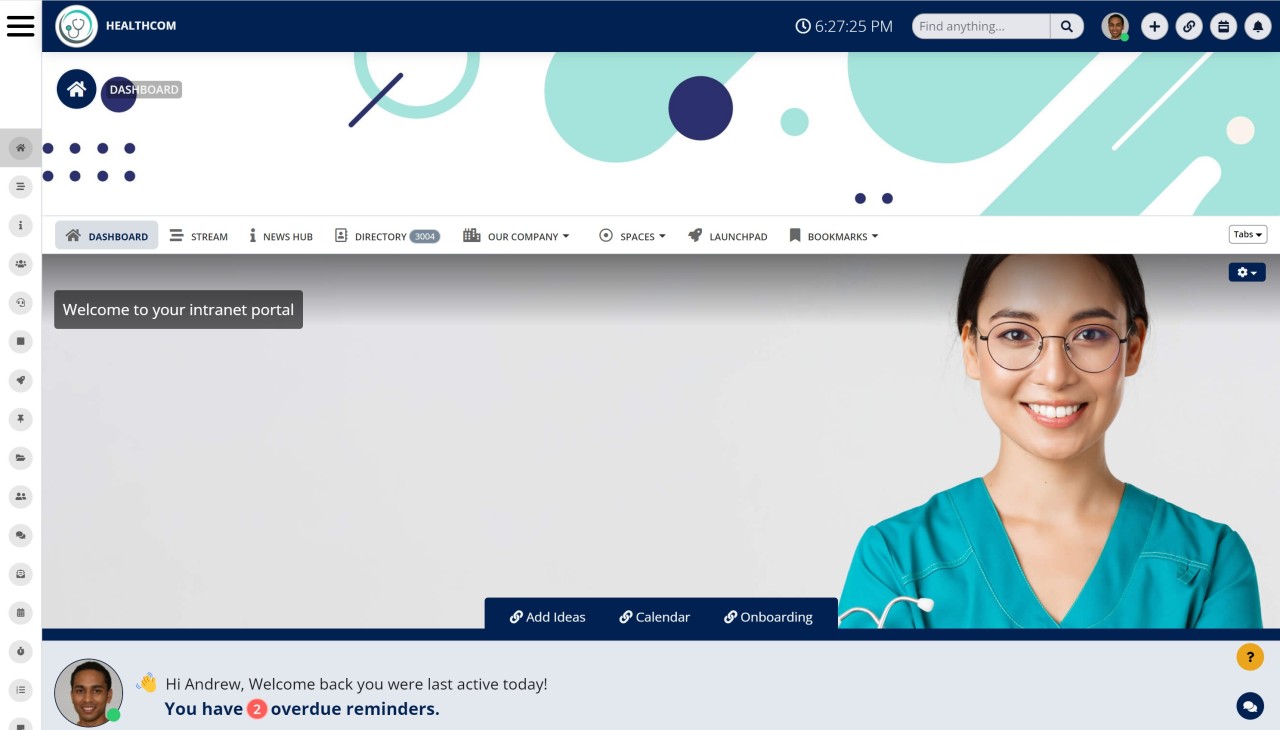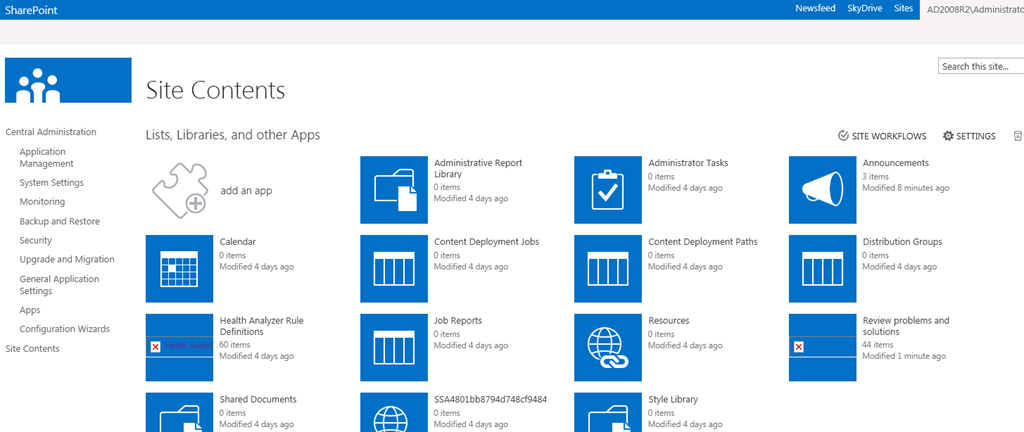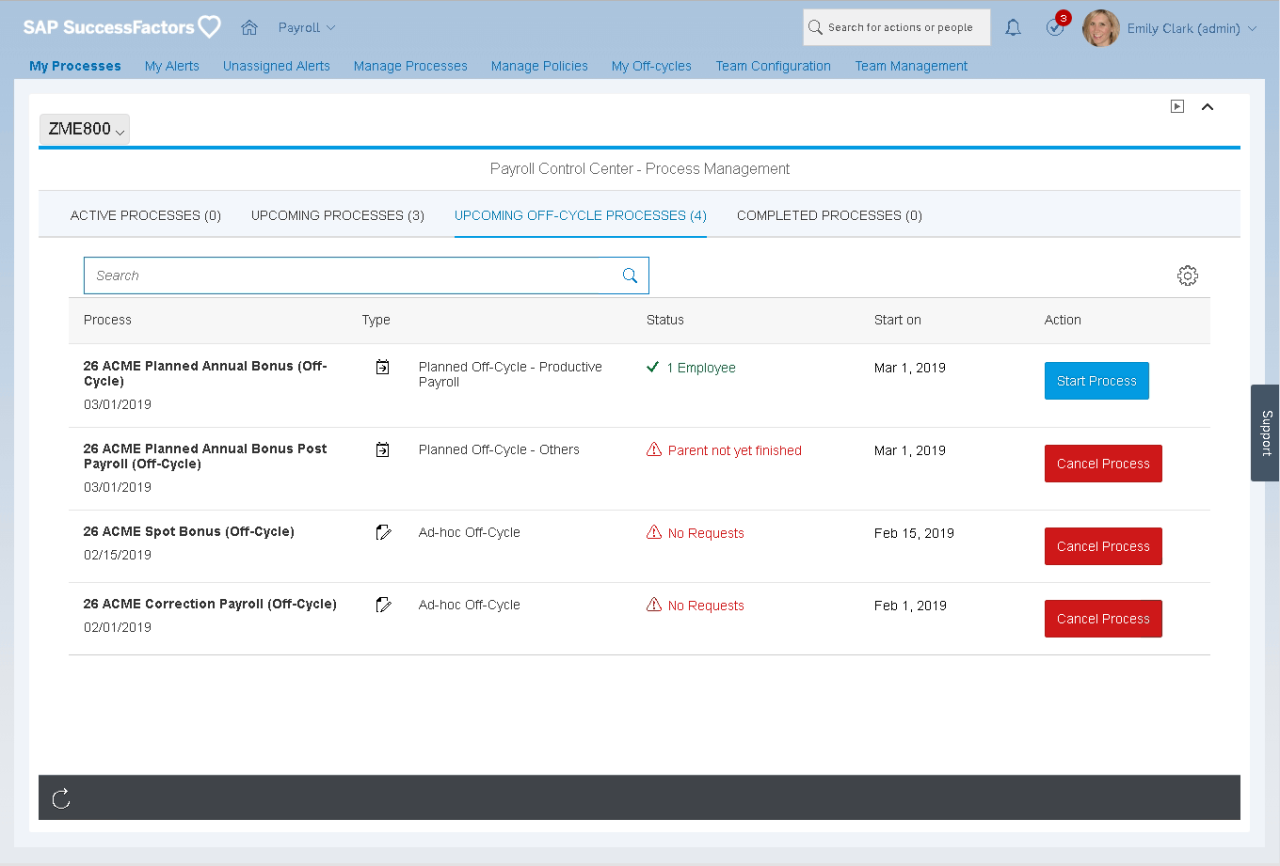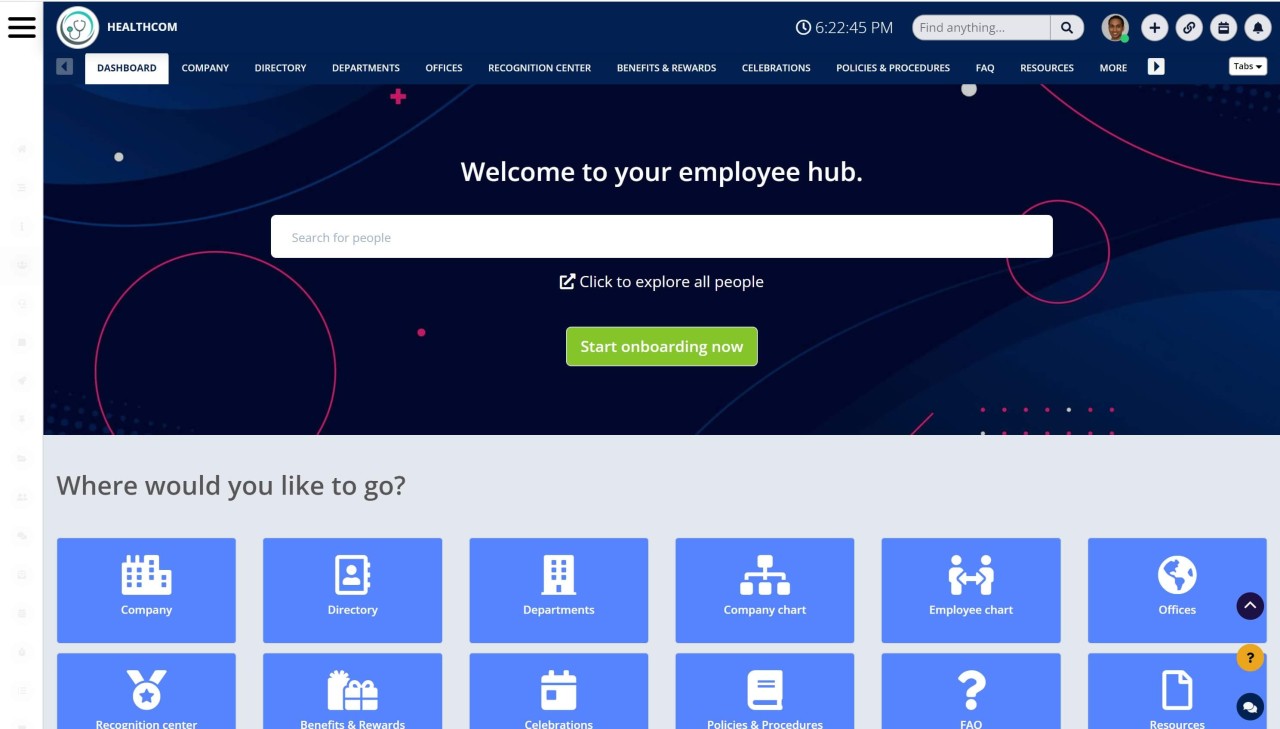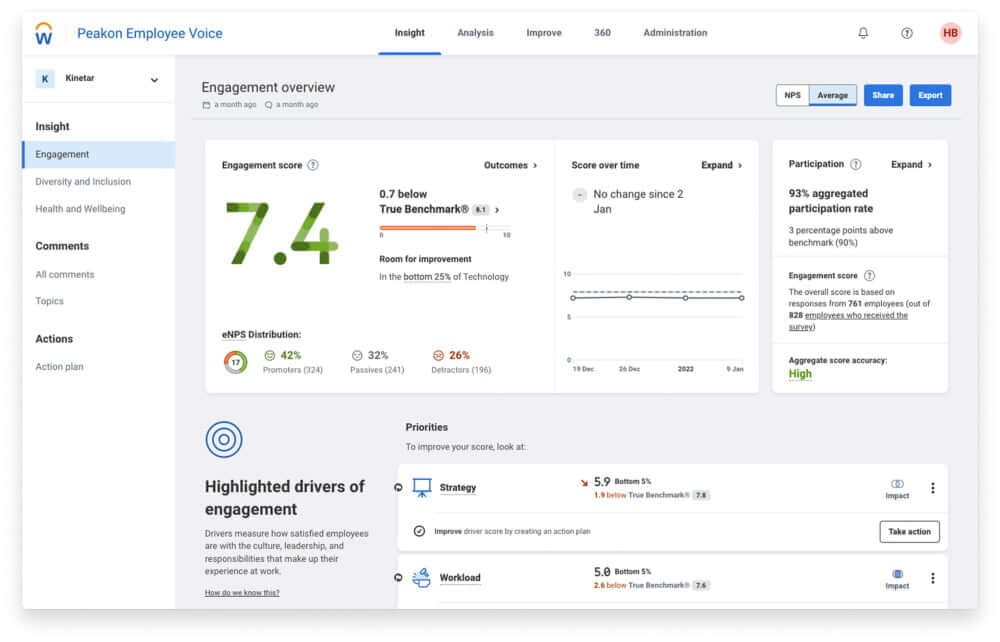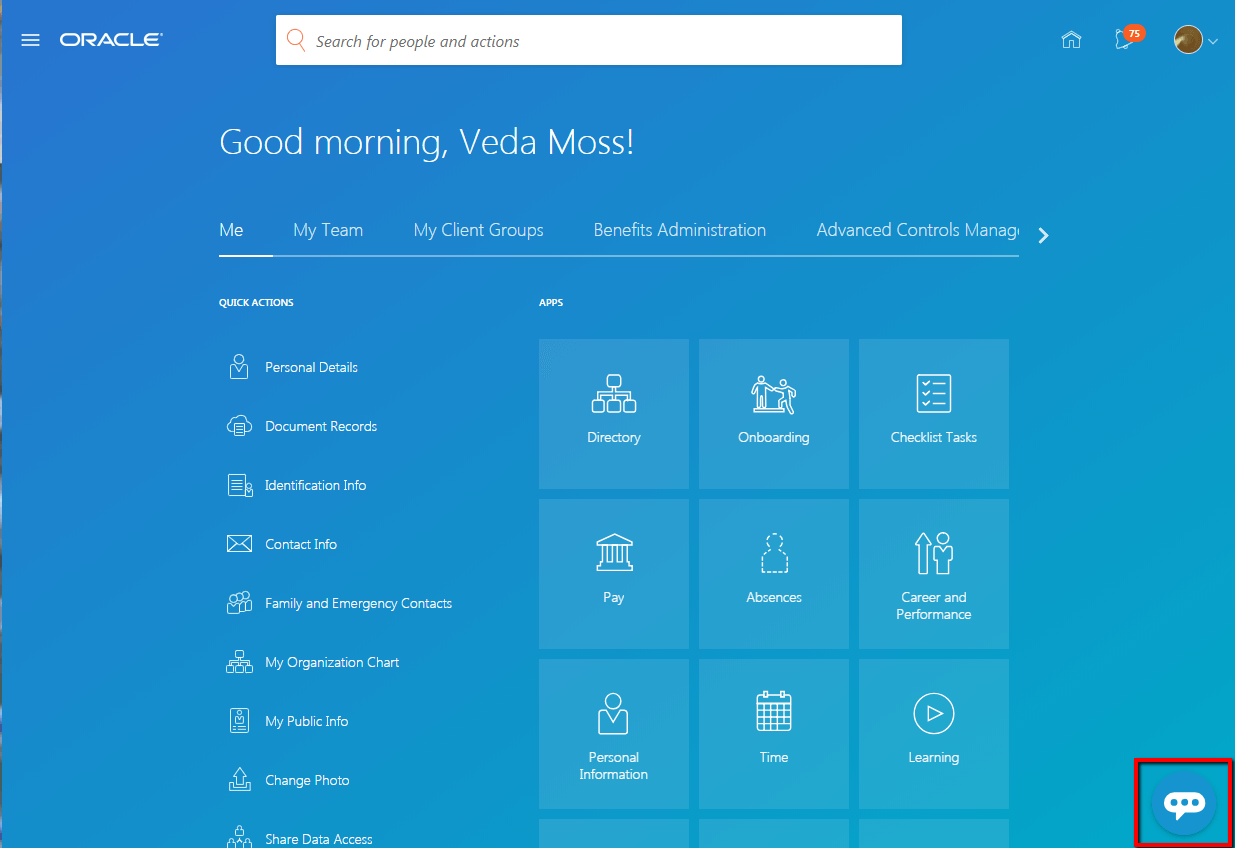Insight Blog
Agility’s perspectives on transforming the employee's experience throughout remote transformation using connected enterprise tools.
18 minutes reading time
(3566 words)
HR intranet:The Benefits of Implementing an HR Intranet in 2023
In this article, we'll take a closer look at the benefits of implementing an HR intranet and explore its key components and functionalities.
According to recent studies, the adoption of HR intranet sites has been steadily increasing among companies of all sizes. In fact, research shows that approximately 83% of organizations now use some form of intranet to manage their HR functions.
Managing human resources (HR) can be a complex and time-consuming task, especially for big companies.
It involves everything from hiring and onboarding new employees to managing performance and benefits administration.
In this digital age, implementing an HR intranet can make it much easier to streamline HR processes, enhance employee engagement, and improve compliance and security.
As more and more workers shift from commuting to the office to simply rolling out of bed and logging onto their laptops, HR departments must adjust their practices accordingly. In order to maximize collaboration, HR teams need to find new ways to work with potential hires, new employees, and seasoned staff alike.
This collaborative approach must go beyond the typical methods of email and file sharing programs.
Without face-to-face interaction, the relationships that are often built in on-site work can be lost or forgotten.
Therefore, HR departments need to explore new tools and techniques for maintaining effective communication and fostering strong working relationships with all employees, regardless of their location or work arrangement.
In this article, we'll take a closer look at the benefits of implementing an HR intranet and explore its key components and functionalities.
Read: Intranets VS Extranets
Understanding what is an HR Intranet
Before delving into the benefits of an HR intranet, it's essential to understand what an HR intranet is and how it works.
An HR intranet is a secure internal website that serves as a one-stop-shop for all Human resources related information and services.
It provides a centralized platform for employees to access company policies, procedures, and training resources. It also allows them to update their personal information, access their performance appraisals, and apply for leaves and benefits.
The best way to look at it is a platform designed to streamline human resources (HR) processes and functions within an organization.
It serves as a private internal network where human resources teams can manage various activities related to recruitment, onboarding, employee engagement, performance management, and other HR functions.
HR intranet is typically accessible only to employees within an organization and is not accessible to the general public. It enables HR teams to automate repetitive tasks, reduce manual errors, and improve data accuracy.
It also facilitates communication and collaboration between HR teams, employees, and managers, enabling them to work together more effectively.
Advanced technologies such as AI, machine learning, and natural language processing are often integrated into HR intranet platforms to further enhance their functionality and efficiency.
Overall, HR intranet has become an essential tool for modern HR management, providing organizations with a centralized platform to manage and optimize their HR processes.
Are intranets still relevant in 2023
In this current day and age, a pivotal question that springs to mind is whether intranets still hold relevance in the year 2023. With the ever-evolving landscape of technological advancements and the incessant emergence of newer and more contemporary solutions, it is a pertinent query to ponder upon.
The notion of intranets has been in existence for quite some time and its relevance in modern times has been a topic of debate.
The question arises as to whether these digital networks are still efficacious in serving their intended purpose, or have they been outpaced by alternative means of communication and information-sharing.
One could argue that intranets may have lost their effectiveness over time, considering the advancements that have been made in modern technology. The rise of social media and cloud computing have given birth to new, more innovative solutions that have the potential to revolutionize the way businesses operate.
Moreover, the trend of remote work has also gained immense traction in recent years, further indicating the need for more advanced means of communication.
On the other hand, the continued usage of intranets in several organizations suggests that they still serve a purpose. Intranets have long been the cornerstone of internal communication and have provided employees with a secure and reliable means of accessing company data.
Additionally, intranets can be customized to cater to specific needs, which makes them a versatile solution for businesses of varying sizes and industries.
Read: Intranet for schools
What are the Key Components of an HR Intranet
An HR intranet should have various functionalities and features essential for HR management. First of all the key question is can intranet be accessed remotely? Typically, intranets are accessible to employees of a given organization, as they serve as a private portal for internal use only. However, it is worth noting that certain individuals outside of the organization may also have access, depending on their level of authorization and security clearance.
These features include:
1.Employee self-service portal:
Employees can access their personal information, benefits enrollment and management, and other HR-related information using an online, self-service portal. This feature provides employees with the ability to manage their own HR tasks, reducing the workload of HR professionals and increasing employee satisfaction.
2.Performance management:
The HR intranet also enables performance management activities such as setting goals, tracking progress, and conducting annual reviews.
This feature allows HR professionals to track employee progress and provide feedback, leading to improved employee performance and increased job satisfaction.
3.Compliance management:
HR professionals can use the intranet to ensure their organization is compliant with legal, regulatory, and industry requirements.
This feature helps companies avoid penalties and legal issues by ensuring that HR policies and procedures are up-to-date and compliant with current regulations.
4.Internal communication:
The intranet can enhance internal communication by providing a platform for team members to share announcements, news, and other important company information.
This feature helps to improve collaboration and teamwork within the organization, leading to increased productivity and job satisfaction.
5.Training and development:
HR professionals can use the intranet to provide access to training and development resources, which can help employees enhance their skills and knowledge.
This feature helps companies to develop their employees and ensure that they are equipped with the necessary skills and knowledge to perform their jobs effectively.
Overall, an HR intranet is an essential tool for HR professionals and employees alike. It provides a centralized platform for managing HR-related activities, simplifying day-to-day operations, and improving employee satisfaction.
With its various functionalities and features, an HR intranet can help companies to stay compliant with regulations, improve communication and collaboration, and develop their employees to their full potential.
How can an HR Intranet Streamlining HR Processes
One of the primary benefits of implementing an HR intranet is that it can streamline HR processes, making them more efficient and less time-consuming. This can result in significant cost savings for the company and increased productivity for HR professionals.
1.Simplifying Employee Onboarding
With an HR intranet, onboarding new employees can be simplified, and the process can be made faster and more efficient. New employees can access online portals, fill out necessary paperwork, and receive company orientation materials through the intranet. This process can significantly reduce the time required to onboard new employees and provide a better onboarding experience.
Moreover, an HR intranet can help new employees feel more connected to the company and its culture. They can access company policies, mission statements, and other important information that can help them understand the company's values and goals.
2.Better and Improved Employee Records Management
Using an HR intranet, HR professionals can store and manage employee records, such as personal information, performance appraisals, and benefits enrollment. This feature ensures that employee data is stored accurately, securely, and in compliance with regulatory and industry requirements.
Moreover, an HR intranet can help HR professionals track employee performance and identify areas for improvement. They can use the data stored in the intranet to create customized training programs and development plans for employees.
3.A More Streamlined Administration
An HR intranet can provide a centralized platform for employees to enroll in and manage their benefits.
Employees can view their benefits package, access their claims forms, and receive updates on their claims status. This feature can reduce HR professionals' workload, resulting in increased efficiency and accuracy when administering the company's benefits program.
Moreover, an HR intranet can help employees make informed decisions about their benefits. They can access information about different plans and compare them to make the best choice for their needs and budget.
4.Centralized Performance Management
Performance appraisals can be a daunting task for HR departments, especially if HR professionals need to collect and analyze data manually.
With an HR intranet, however, HR professionals can streamline the performance management process by creating customized appraisal forms, tracking progress, and maintaining employee records.
Employees can also access their performance appraisal results and feedback through the intranet, enhancing transparency and communication.
Moreover, an HR intranet can help HR professionals identify high-performing employees and reward them accordingly.
They can use the data stored in the intranet to create incentive programs and recognition initiatives that can motivate employees to perform at their best.
Overall, implementing an HR intranet can bring numerous benefits to a company, from cost savings to increased productivity and employee satisfaction.
It can help HR professionals focus on strategic initiatives and leave the administrative tasks to the intranet, resulting in a more efficient and effective HR department.
Enhancing Employee Engagement
An HR intranet can enhance employee engagement by providing a platform for internal communication, promoting collaboration, and providing access to training and development resources. In this digital age, an HR intranet is a valuable tool for companies to improve employee engagement and productivity.
1.Facilitating Internal Communication
The intranet can provide a centralized platform for employees to communicate with one another, share knowledge, and exchange ideas.
This platform can be used to share important company news and updates, such as changes in policies or upcoming events.
Employees can also use the intranet to communicate with HR professionals, team members, and managers. This can help to streamline communication within the organization, ensuring that everyone is on the same page.
Moreover, the intranet can be used to create discussion forums and chat groups where employees can engage in conversations and share their thoughts and ideas. This can help to foster a sense of community within the organization, which is essential for employee engagement.
2.Promoting Collaboration and Teamwork
An HR intranet can also promote collaboration and teamwork by providing an environment where employees can work together virtually. They can share files and documents, collaborate on projects and assignments, and engage in group discussions. This can help to break down silos within the organization and encourage employees to work together towards a common goal.
Collaboration tools such as video conferencing and screen sharing can also be integrated into the intranet, allowing employees to work together in real-time, regardless of their physical location. This can be particularly useful for remote teams or employees who work in different time zones.
3.Providing Access to Training and Development Resources
Employees can access necessary training and development resources through the intranet. HR professionals can post training materials and resources, manage online courses, and track employee progress. This feature can enhance employee skills and knowledge, resulting in a more productive and effective workforce.
Moreover, the intranet can be used to create a knowledge base where employees can access information about the company, industry trends, and best practices. This can help to keep employees informed and up-to-date, which can lead to better decision-making and improved performance.
In conclusion, an HR intranet is a powerful tool for enhancing employee engagement. By facilitating internal communication, promoting collaboration and teamwork, and providing access to training and development resources, companies can create a more engaged and productive workforce.
Improving Compliance and Security
Finally, an HR intranet can improve compliance and security within an organization. This is crucial for any company that wants to avoid legal issues and protect its employees' data.
1.Ensuring Data Privacy and Security
HR intranets are designed to be secure, and measures are in place to ensure that employee data privacy and security are maintained. Users can only access the intranet if they have the proper login credentials, and access to sensitive information is restricted to authorized personnel.
One of the key ways an HR intranet can ensure data privacy and security is by encrypting all data that is transmitted between the user's computer and the server. This means that even if someone intercepts the data, they won't be able to read it.
In addition, an HR intranet can also help prevent data breaches by providing HR professionals with tools to monitor user activity and detect any suspicious behavior. For example, if an employee tries to access sensitive information that they shouldn't have access to, the system can send an alert to the HR department.
2.Simplifying Compliance Management
The intranet can also help HR professionals ensure their organization stays compliant with legal, regulatory, and industry requirements. HR professionals can post compliance-related information, track compliance progress, and manage compliance-related tasks.
For example, an HR intranet can provide access to up-to-date information on employment laws and regulations, making it easier for HR professionals to stay compliant. It can also provide tools for tracking compliance-related tasks, such as training requirements or reporting deadlines.
3.Reducing Human Error and Risk
Finally, implementing an HR intranet can reduce human error and mitigate risks, such as incorrect data entry, lost paperwork or important documents, or data breaches. HR professionals can manage and store employee records on a centralized platform, reducing redundancies and providing greater control over data management.
For example, an HR intranet can provide a secure and centralized location for storing employee records, such as resumes, performance reviews, and disciplinary actions.
This can help prevent important documents from being lost or misplaced, and can make it easier for HR professionals to access the information they need.
In addition, an HR intranet can help reduce the risk of data breaches by providing tools for managing user access and permissions.
For example, HR professionals can restrict access to sensitive information to only those employees who need it, reducing the risk of data being leaked or stolen.
Overall, implementing an HR intranet can have a significant impact on an organization's compliance and security.
By ensuring data privacy and security, simplifying compliance management, and reducing human error and risk, an HR intranet can help an organization to operate more efficiently and effectively.
HR Intranet Site Examples
1.Microsoft SharePoint:
This is a popular platform for building HR intranet sites. It allows organizations to create customized sites to manage HR functions such as onboarding, performance management, and benefits administration.
- A self-service portal where employees can manage their personal information, view their pay and benefits, and update their profiles. This feature can reduce administrative workload for HR managers and empower employees to manage their own HR-related tasks.
- SharePoint can streamline the onboarding and offboarding processes by automating workflows for new hires and exits. HR managers can use this feature to ensure that all necessary steps are taken to get new employees up to speed and to ensure that all offboarding steps are completed.
- Can facilitate performance management by providing a platform for managers to set goals, track progress, and provide feedback. HR managers can use this feature to monitor performance across the organization and identify areas for improvement.
- You can deliver training and development programs to employees. HR managers can use this feature to create and manage training courses, track employee progress, and assess the effectiveness of training programs.
- Managing HR-related documents such as policies, procedures, and employee handbooks. HR managers can use this feature to ensure that all employees have access to the latest HR documents and to maintain compliance with regulatory requirements.
2.SAP SuccessFactors
SAP SuccessFactors: This is a cloud-based HR software suite that includes an intranet platform. It enables HR teams to manage various HR activities such as recruiting, employee development, and performance management.
Here are some stand out features HR features of SAP SuccessFactors:
- The recruiting feature of SAP SuccessFactors helps organizations attract, engage, and hire the best candidates for open positions. It includes tools for job posting, candidate management, and interview scheduling.
- SAP SuccessFactors offers a comprehensive performance management system that enables organizations to set goals, provide feedback, and evaluate employee performance. It includes features such as goal setting, continuous feedback, and performance analytics.
- The learning management feature of SAP SuccessFactors enables organizations to provide employee training and development programs. It includes tools for creating and managing courses, tracking employee progress, and reporting on training effectiveness.
- SAP SuccessFactors provides a compensation management system that enables organizations to manage employee compensation and rewards programs. It includes tools for creating and managing pay structures, bonuses, and other incentives.
- The succession planning feature of SAP SuccessFactors helps organizations identify and develop key talent within the organization. It includes tools for creating talent profiles, identifying high-potential employees, and developing career plans.
3.AgilityPortal
AgilityPortal provides your Human Resources team with the perfect HR intranet solution to make employee management easier. It offers features such as employee self-service, document management, and benefits administration.
- Allows employees to access and manage their personal information, such as contact details, pay stubs, and leave balances. This feature saves HR professionals time by reducing the need for manual data entry and paperwork.
- Performance management module helps businesses track employee goals and performance metrics. Managers can provide feedback and coaching, and employees can self-assess their progress. This feature helps align individual goals with organizational objectives, improving employee engagement and productivity.
- Offers a complete recruitment and applicant tracking system that streamlines the hiring process. It enables HR professionals to post job openings, accept and manage applications, and track candidate progress throughout the recruitment process.
- Onboarding feature helps new employees get up to speed quickly. It provides new hires with access to company policies and procedures, job descriptions, training materials, and other essential information. This feature helps new employees feel welcome and engaged from day one.
- Time and attendance module provides accurate and reliable time tracking. It enables employees to clock in and out, request time off, and track their hours worked. This feature helps HR professionals maintain accurate attendance records and ensures compliance with labor laws and regulations.
4.Workday
This is a cloud-based HR management system that includes an intranet platform. It provides features such as recruiting, performance management, and time tracking.
- Workday's HCM feature offers a range of HR functions, including recruitment, talent management, performance management, and succession planning.
- Time Tracking feature allows employees to track their time worked, absences, and vacations. This feature can help managers to manage employee work schedules and payroll.
- Compensation Management feature, organizations can manage employee compensation packages, including salaries, bonuses, and benefits.
- Learning Management feature provides a platform for employee training and development. It allows employees to take courses, track their progress, and earn certifications.
- Analytics and Reporting feature provides insights into HR data, such as workforce demographics, turnover rates, and employee engagement. It allows organizations to make data-driven decisions and improve their HR strategies.
5.Oracle HCM Cloud
This is a cloud-based HR management system that includes an intranet platform. It provides features such as HR analytics, benefits administration, and payroll management.
- The Core HR module is the foundation of Oracle HCM Cloud. It provides a central repository for employee data, including personal information, job details, and employment history. With Core HR, organizations can automate administrative tasks, such as onboarding and offboarding, and ensure compliance with regulations.
- The Talent Management module helps organizations manage their talent effectively by identifying and nurturing high-performing employees. This module includes features like performance management, goal setting, and succession planning. With Talent Management, organizations can align employee goals with business objectives and ensure that their workforce is skilled and capable.
- Analytics provides real-time insights into employee data, allowing organizations to make data-driven decisions about their workforce. This module includes features like dashboards, reports, and data visualizations that can help organizations identify trends, track key performance indicators, and monitor employee engagement.
- The Payroll Management module streamlines the payroll process by automating tasks like tax calculations, deductions, and payments. With Payroll Management, organizations can ensure compliance with local tax laws and regulations, and reduce errors and discrepancies.
- With mobile access, employees and managers can access Oracle HCM Cloud from anywhere, at any time. Mobile access allows employees to view their schedules, request time off, and access their pay and benefits information, while managers can approve requests, view analytics, and manage their team on the go. This feature can enhance the user experience and improve productivity.
Wrapping up
An HR intranet is a valuable tool for managing an organization's human resources. It can streamline HR processes, enhance employee engagement, and improve compliance and security.
By implementing an HR intranet, organizations can ensure that their HR management practices are efficient, effective, and compliant.
Using the various functionalities and features of an HR intranet, HR professionals can focus on what matters most to their organizations - their employees' success and growth.
Categories
Blog
(2596)
Business Management
(318)
Employee Engagement
(206)
Digital Transformation
(173)
Intranets
(119)
Growth
(118)
Remote Work
(61)
Sales
(48)
Collaboration
(37)
Culture
(29)
Project management
(29)
Customer Experience
(26)
Knowledge Management
(21)
Leadership
(20)
Comparisons
(5)
Ready to learn more? 👍
One platform to optimize, manage and track all of your teams. Your new digital workplace is a click away. 🚀
Free for 14 days, no credit card required.




